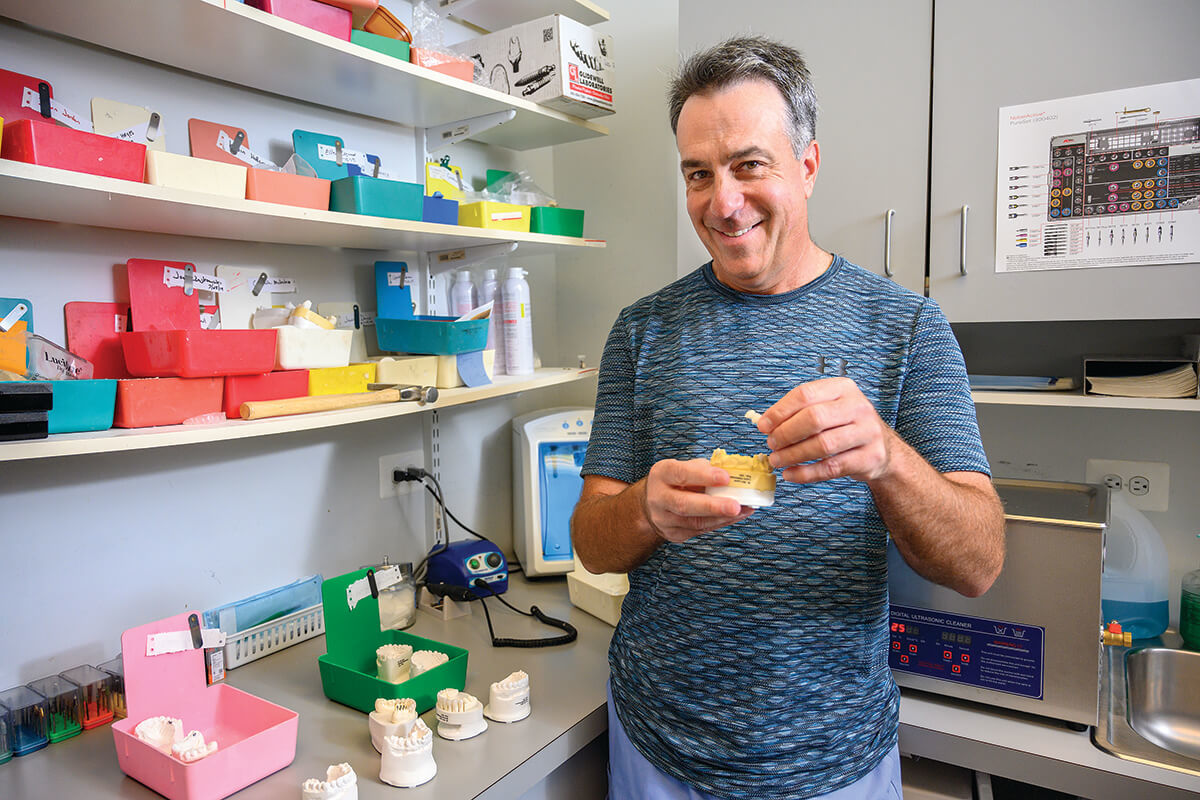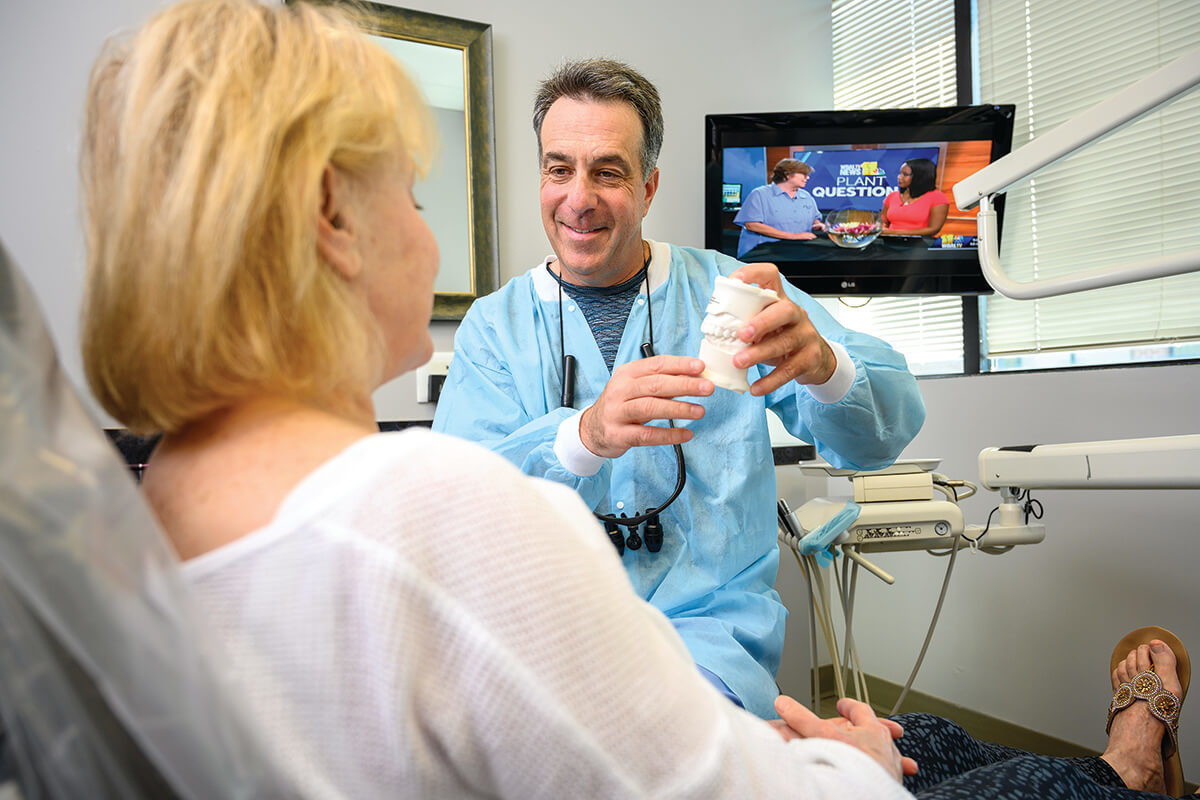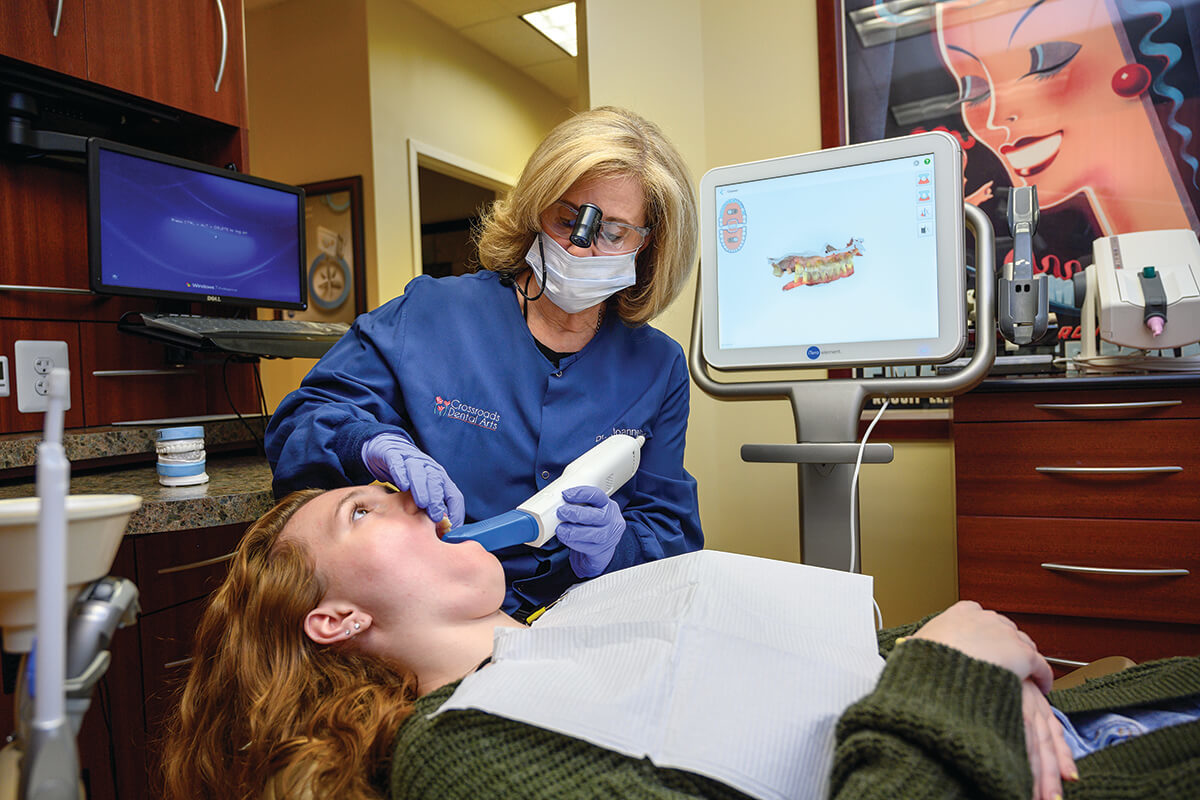Special Section
Putting the Teeth in High Tech
Advances in both general and cosmetic dentistry can put a perfect smile on your face.
By Alice Shapin — September 2019
The world is looking a lot different these days—or soon will be—with robots moving from factories to fast-food restaurants, drones delivering pizzas and packages, and driverless cars taking over our roads. And the story is no different in dentistry, which is morphing into a high-tech environment that’s allowing dentists to diagnose and treat with remarkable precision. For the patient, this means treatments are more efficient, comfortable, and effective. And the advances are also offering big advantages in the field of cosmetic dentistry.
One example—if you haven’t been to a dentist in a while and still can’t forget those horrible icky impressions, relax. Now there’s an intraoral scanner that creates a digital impression just by running a wand around your teeth. Dr. Bradley Olson, who practices in Waldorf, says, “It has revolutionized the accuracy, speed, and comfort of doing impressions.”
Maybe you’ve already seen this high-tech piece of equipment in your dentist’s office: a dental cone beam computer tomography (CT) scanner. It produces a three-dimensional image of your teeth, soft tissues, nerve pathways, and bone in a single scan. “CT scanners are more advanced and provide higher resolution,” and are used before proceeding with orthodontic, implant, or other dental issues, says Dr. Dria Hamrah, a triple-board-certified oral and maxillofacial and facial cosmetic surgeon who practices in McLean, Virginia.
Even your phone has gotten in on the act, namely with Invisalign. There’s an app that gives you reminders and notifications when it’s time to change your aligners, helps you stay compliant with your doctor’s recommended wear time, lets you see how your smile is improving on each aligner change, and saves photos to your smile gallery as your treatment progresses.
And remember the first time you went to a restaurant and the kitchen was open and visible from your table? While things such as crowns once had to be made off-site, the same thing could now happen in your dentist’s office—if you need a new tooth, you might actually see it being made. Cosmetic dentist Dr. Peter Rinaldi has a new Chevy Chase office where the lab will be visible from the waiting room and hallway. “Patients can see their restorations being made on the computer, then milled in the machine,” he says. “This is all possible because there is no need to take putty impressions. The patient’s mouth is scanned with a video camera, which goes directly to the ceramist’s computer for them to fabricate the restoration.”
Wondering if robots will make it into your dentist’s office? You won’t have to wait long: ScienceDaily predicts that your next dental assistant may be a robot. And a team of engineers, dentists, and biologists from the University of Pennsylvania has already developed a microscopic robotic cleaning crew that may take care of the sometimes unpleasant mechanical scraping to remove plaque from teeth. Instead, the dentist could deploy a small army of tiny robots to precisely and non-invasively remove that buildup. It could also help reduce the risk of tooth decay, endodontic infections, and implant contamination.

Getting that Million Dollar Smile
No matter what their age, everyone wants a great smile. After all, a nice set of pearlies can light up your whole face and give you confidence. According to a survey by the American Academy of Cosmetic Dentistry (AACD), virtually all Americans believe a smile is an important social asset, and three-quarters of adults feel an unattractive smile can hurt a person’s chances for career success.
And, of course, we can’t forget that social media is fueling the quest for that beautiful smile. “Being photographed and seeing their peers—and not just movie stars—having great smiles pushes people to want a better look,” says Dr. Rinaldi.
Now high tech can get you that beautiful smile. “Digital smile design is becoming more popular in upscale cosmetic practices,” says Rinaldi. “The computer can generate a potential new smile on a patient based on facial characteristics and personality. The pictures can be manipulated and adjusted to suit the patient. This preview can be printed as a model or a template for treatment.”
And if you have chipped, missing, crooked, or yellow teeth, they can all be fixed, too. But, of course, every problem is different, and so is the solution.

Dr. Joanne Block Rief, who represents the third generation of dentists in her family, practices in Owings Mills.
-Christopher Myers
Dennis Taitano of La Plata was retiring and starting a second career as a consultant. “I knew that how I presented myself was very important in this new job.” He realized his smile just didn’t cut it. “I’ve always hated how my teeth looked. Being the youngest of eight children, my parents didn’t have the money for braces, and I had an injury to my front tooth when I was young.” Taitano went to Dr. Olson, who determined that before any cosmetic improvements could be made, Taitano would need some major preliminary work done. “It’s like building a house: You first need a good foundation. Taitano was sent to an orthodontist, where he got Invisalign and braces, then to a periodontist for implants. When that was done, Dr. Olson did veneers and crowns. “It was a long, expensive journey. But, in the end, I got the smile I never had,” says a now-confident Taitano.
But while everyone wants that beautiful smile, today more patients are requesting cosmetic services that stress naturalism over idealism, according to the AACD. Whereas people used to want the most perfectly shaped teeth, more and more customers, especially those in the Generation Y demographic, are requesting cosmetic treatments that subtly enhance their smiles.
Teeth Whitening
One of the least expensive ways to make your smile better is with teeth whitening. According to the last survey done by the AACD, teeth whitening remains the number one requested cosmetic dental service. When we consume certain foods and drinks (soda, spicy food, coffee, etc.), our teeth get stained.
The two most common ways to whiten your teeth are professional and do-it-yourself solutions using over-the-counter products that are less expensive and include whitening strips, brush-on whitening gel, and whitening toothpastes.
The main methods of professional whitening are in-office whitening and tray whitening. The advantage of an in-office treatment is that it’s the most efficient and can be done in one session. With take-home trays, an impression is taken and a custom tray is made, then a supply of whitening gel is given to the patient, who wears the tray for a few hours each day for a period of time until an acceptable result is achieved. Older teenagers and people whose teeth aren’t badly stained may want to use one of the many over-the-counter options, though dentists advise people under age 13 not to use teeth bleaching.

Porcelain Veneers and Bonding
Have a gap between your teeth, stains, slightly crooked teeth, or a chipped tooth? Veneers may be the answer. Or maybe bonding could do the job. Both conceal aesthetic imperfections, with bonding being the least expensive way to go.
A tooth can be fixed to look more natural than in the past thanks to improvements in the bonding material. The material, a resin, is now available in a wider range of shades so dentists can match the material to the tooth’s natural color.
After matching the color, the dentist sometimes roughens the surface of the tooth and then applies a liquid that allows the bonding agent to stick to the tooth. The composite resin is applied over the liquid and then the dentist molds or shapes the tooth. The final step is to apply a type of light that hardens the material.
Porcelain veneers are the second most popular cosmetic procedure, according to the AACD, because they look natural. According to the American Dental Association (ADA), veneers are ultra-thin custom-made porcelain shells that are crafted of tooth-colored materials and designed to cover the front side of existing teeth. Veneers can correct very badly stained, chipped, and misaligned teeth, as well as poor tooth size. The advantage is that porcelain, being translucent, allows some light to pass through so they look very natural, don’t stain, and last between 12 to 14 years. But remember that veneers can’t be whitened.

The Implant Solution
Missing a tooth or teeth? Don’t know if you should get dentures, have bridgework, or try dental implants? The advantage of an implant is that it feels like a natural tooth, lasts up to 20 years when there’s proper oral hygiene, won’t slip when chewing, and doesn’t put stress on adjacent teeth.
There are three parts to an implant—an artificial tooth root similar in shape to screws that bond with your natural bone; an abutment that is placed on top to support the crown, and the crown itself, which is designed to match your natural teeth and fit your mouth.
Today implants in a day are becoming more mainstream. “As technology improves, we can digitally design the case from the surgical to the restorative treatment at one time,” says Dr. Rinaldi. “Therefore, we are better able to control all the steps along the way. So, instead of several visits, a patient can have the tooth in a day.”
Get It Straight
Teeth can shift over time, especially when people haven’t worn their retainers. Years ago, when braces were the only fix, many people ignored the problem. But Invisalign changed all that. Invisalign works for overlapping teeth, bite, and spaces. The best part is that these clear aligners, which are custom-made for each patient, are invisible. Patients wear them 20 to 22 hours a day and take them out when eating and to brush and floss. Each aligner shifts their teeth slightly. And for each incremental movement, a new clear plastic aligner is given to you. Today, Invisalign can even be used to fix a single tooth.
